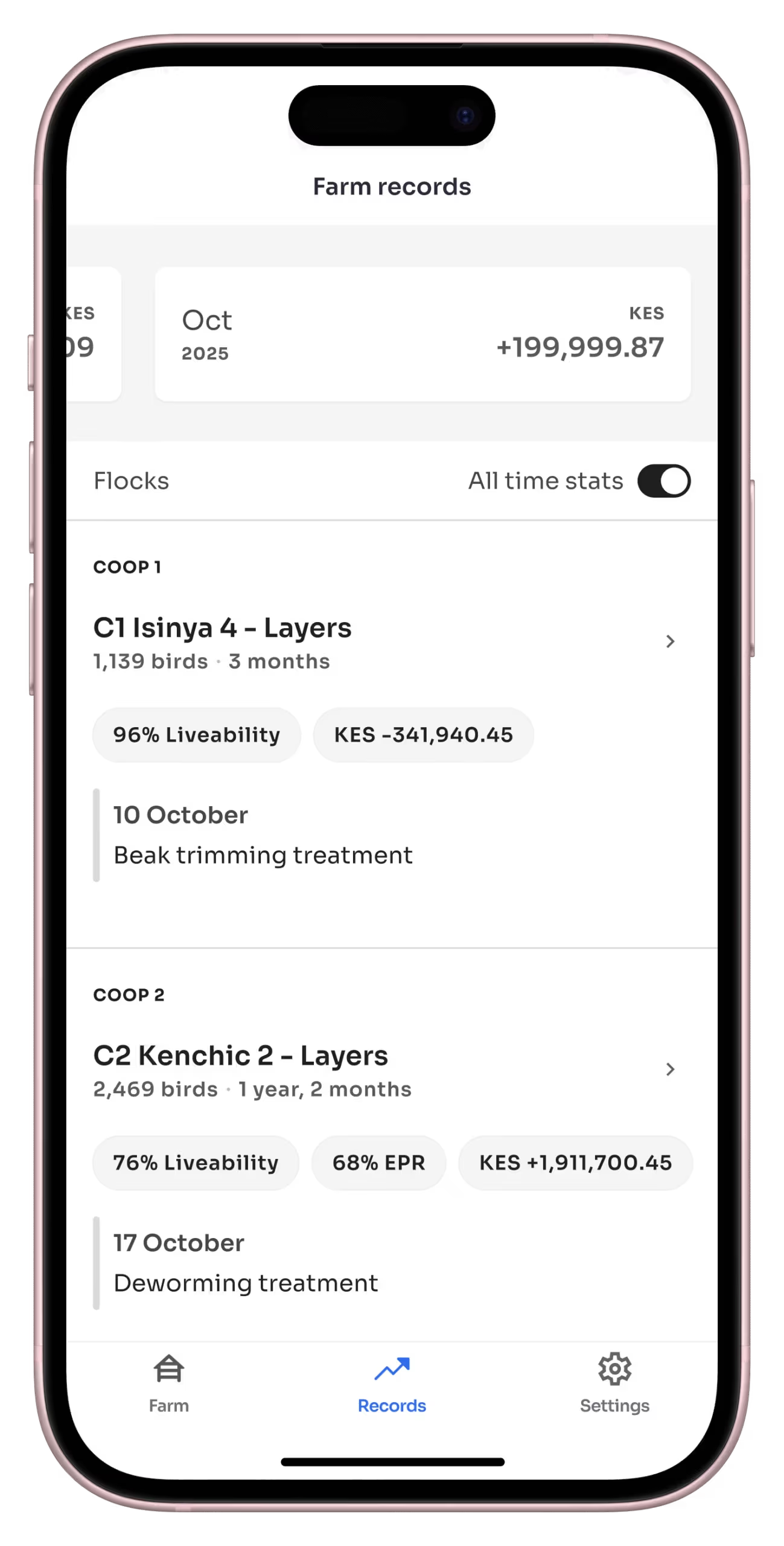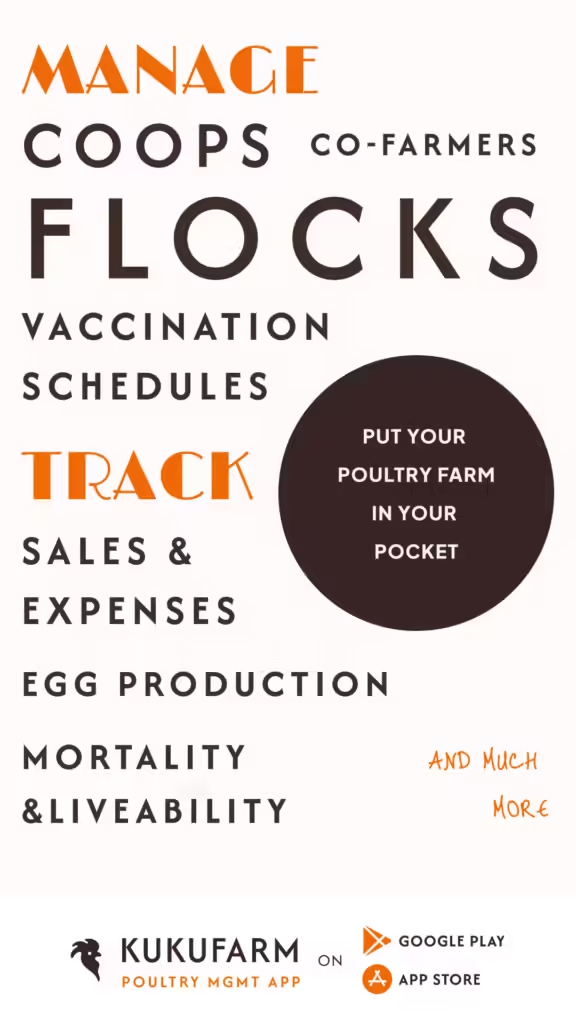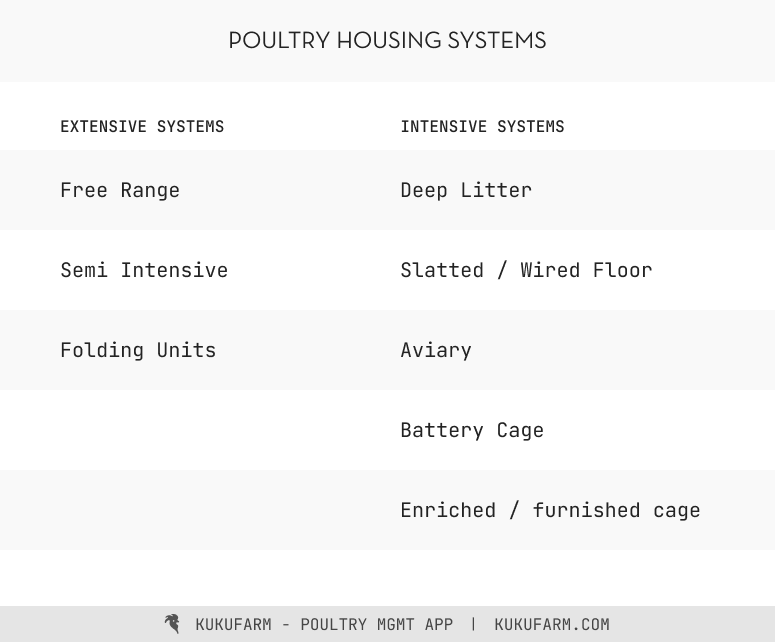There are 8 commonly used poultry housing systems. These are free range, semi intensive, folding unit, deep litter, slatted floor, aviary and cage battery systems. Moreover, these systems are grouped in to two main categories: extensive and intensive poultry systems.

Poultry housing system refers to the way poultry birds are housed including their access to the outdoors, feeding method, and so on.
Your choice of poultry farming and housing system is determined by a number of factors such as accessibility to land and capital. Below, we discuss 8 poultry housing systems. You may also be interested in commonly used terms and definitions in poultry management and record keeping.

Extensive and intensive poultry systems grouping
There are subcategories under extensive and intensive poultry systems, as shown in the table below:

As shown above, there are 3 main poultry housing systems under extensive category. On the other hand, there are 5 main poultry systems categorized as intensive.
Extensive poultry housing systems
Free range poultry housing systems
In free range housing system, poultry birds have access to the outdoors. This means that birds are allowed free movement, and feeding on vegetation for the better part of the day. Birds however, have access to a coop for nesting and sheltering from the sun, and at night.
Free range housing is ideal if you have access to pasture where chickens can feed and roam freely. The bigger the flock, the bigger the pasture required so birds can move freely and have access vegetation.
Free range poultry mean that birds only feed on vegetation. However, you can provide chicken feed to a free range flock. That is, birds in a free range system can be supplemented with chicken feed.
In general, free range birds have access to a richer nutrition. In contrast to other differently housed flocks, free range birds have access to a variation of insects, seeds, and vegetation.
Read more about free range farmer experiences on Backyard Chicken.
Free range system pros and cons
| Pros | Cons |
|---|---|
| A small coop suffices since birds are only housed at night | Requires extra care to ensure birds do not fall prey to wild birds and animals |
| Minimal or zero chicken feed required | Possibility to lose eggs laid in the pasture |
| Pastures are replenished from litter | Require huge grazing pastures with large flock size |
| Minimal need for coop cleaning | Scientific methods cannot be applied effectively |
| Birds can access a variety of vegetation, bugs and seeds |
Semi intensive poultry housing systems
In semi intensive housing birds are housed, but are allowed access to the outdoors from time to time. This system gives you flexibility on how you feed your chicken.

Essentially, the semi intensive system is a hybrid of free range and intensive systems. As a result, with this system, you can apply some scientific flock management methods. This system may be ideal for dual purpose and heritage or native breeds.
Pros and cons of semi intensive housing
| Pros | Cons |
|---|---|
| Requires less land than free range system | Regular feed switching can result to fluctuating egg production |
| Enables flexibility in feed choice | |
| Birds have access to the outdoors from time to time |
Folding unit poultry housing systems
In a folding unit housing, birds are housed in a mobile unit that consists of a coop and free run area. The mobile coop serves as a means to move birds from one pasture to another.

Pros and cons of a folding housing
| Pros | Cons |
|---|---|
| Less capital intensive | Housing and water have to be moved with every flock moving |
| Birds have access to the outdoors | Moving housing can be labor intensive |
| Birds have access to richer nutrition from bugs, seeds and vegetation | This method can be more expensive than free range and semi intensive methods |
| Moving flocks enables vegetation to regenerate |
Intensive poultry housing system
Intensive housing systems are mostly used in large commercial farms with huge flocks. There are 4 main types of intensive housing system:
- Deep litter
- Slated or Wired floor
- Aviaries
- Cage / Battery system
Deep litter system
In a deep litter housing system, litter from birds is allowed to accumulate on the floor, which is the living surface. Initially, bedding material such as saw dust or wood shavings covers the ground. As a flock lives in the space, it accumulates litter. Consequently, this forms a deep litter which the system is named after.

The accumulated litter serves two purposes. Firstly, it serves as a bedding material and two, as bathing dirt. Secondly, deep litter does not require frequent cleaning since the idea is to allow the accumulation of litter.
Since birds are in direct contact with litter, they can develop various ailment including respiratory issues. Furthermore, the litter usually harbours poultry diseases which can be easily transmitted to new flocks. Because of this, a deep litter system requires intensive cleaning and disinfection before a new flock can occupy the space.
Slated / Wired floor system
In a slated or wired floor housing system, birds are kept on meshed floors that are placed above the ground. As a result, this system keeps birds out of contact with the ground. Since the slated or wired mesh serves as the living space, no bedding material is required.

Slated housing enables a cleaner living space since litter falls via the mesh to the ground. However, this system gives less flexibility in space usage. Slated housing system is an alternative when a farmer does not want to use deep litter housing.
Slated and deep litter housing systems can be combined to form a hybrid system known as slat floor cum litter housing system.
Aviaries poultry housing systems
Aviary housing system is also known as multi-tier system. In an aviary, living spaces are organized into multiple levels. As a result, an aviary affords more space for movement to birds. Additionally, it enables the stocking of a large flock in a limited space.
For these reasons, an aviary is considered the best alternative to caged housing system.

Living spaces, in an aviary, can be stacked upto 4 levels. Consequently, this provides the capacity to house more birds, in contrast to ground or single level housing.
Battery cage system
In a cage or battery housing system, birds are kept in small compartments or cages. Usually, these are fixed to stands, and have feed and water delivery systems attached to them.
Cage housing system can have fully automate flock feeding, watering, and egg collection. As a result, this can reduce labor costs immensely for you, but it requires huge initial investments.

Battery cage housing system is the most advanced housing system. It enables you to apply efficient and scientific farming methods.
Keep in mind that birds in cage housing can suffer from cage paralysis or layer fatigue. Other conditions to watch out for include blood spotted eggs and breast blisters for broiler birds.
Pros and cons of intensive housing systems
| Pros | Cons |
|---|---|
| Ideal for applying scientific methods | Capital intensive |
| Can support large flocks on small land | Birds’ have no access to the outdoors |
| Feeding, watering, egg collection and coop cleaning can be semi- or fully automated | Birds’ movement may be limited especially if they are crowded |
Enriched cage
The enriched cage poultry system was invented to overcome some animal welfare issues and concerns of battery cage system. Additionally, the system was meant to provide the advantages of other poultry systems while maintaining high productivity.

There are a number of noted features in an enriched cage system, in contrast to traditional cages. These features include:
- Bigger cages
- Nesting boxes
- Perches
- Litter / scratching area
In general, enriched cage system is aimed at improving overall animal welfare. It affords birds more space to engage in natural movement and behaviors. That is, in contrast to traditional cages.
But is enriched cage better than battery cage system from an animal welfare view?
Cage systems in general have low animal welfare ratings. Consequently all cage systems including enriched cage are set to be banned in the EU by 2027. We can only expect other countries and blocs to follow suit thereafter.

Key takeaways
- Choice for housing system depends the type of poultry farming you want
- In addition, access to land, and initial capital can determine the type of housing system you will use
- Intensive housing is ideal for rearing large flocks and applying scientific methods
- Some parts of flock management can be semi or fully automated in intensive housing systems





7 responses to “8 Types of poultry housing systems: Everything you need to know”
•
[…] poultry housing system should also be free of pests and parasites, and should be properly cleaned and fumigated before […]
•
[…] on the poultry farming method through which they are produced, eggs are prone to developing bacteria that causes food poisoning […]
•
[…] of dirt as a bathing material depends on the poultry housing system you […]
•
[…] on the poultry housing system you employ in your poultry farm, you will need some flooring or bedding material for your chicken. […]
•
[…] the staple of social media posts on poultry farming is poultry housing. Most posts showcase applied poultry housing systems, and inform other farmers of housing system options and […]
•
[…] Types of poultry housing systems […]
•
[…] financial element may affect the choice of poultry housing system you select for your chicken. In deep litter for example, birds rely solely on purchased feed while […]